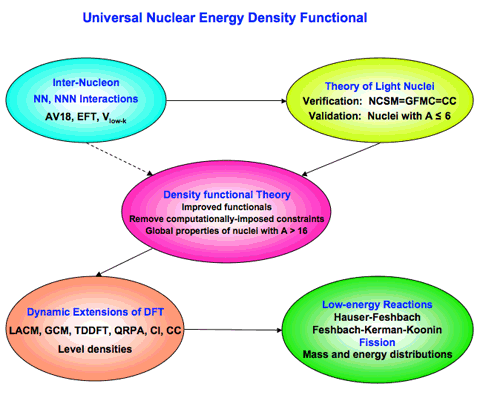A Closer Look at Nuclei
Building a Universal Nuclear Energy Density Functional
Supporting the Low-Energy Nuclear Physics National HPC Initiative
 There are approximately 3,000 known nuclei, most of them produced in
the laboratory. It is estimated that additionally up to approximately
6,000 nuclei could in principle still be created and studied in the
foreseeable future. An understanding of the properties of these
elements is crucial for a complete nuclear theory, for element
formation, for properties of stars, and for present and future energy
and defense applications. We plan a comprehensive study of all these
nuclei, based on the most accurate knowledge of the strong nuclear
interaction, the most reliable theoretical approaches, and a massive
use of the computer power available at this moment in time, with the
view of scaling to the petaflop computers to become available in the
near future. Until recently such an undertaking was hard to imagine,
and even at the present time such an ambitious endeavor would be far
beyond what a single researcher or a traditional research group could
carry out. This project will involve theoretical physicists, computer
scientists, and students from universities and national laboratories.
Our long-term vision is to arrive at a comprehensive and unified
description of nuclei and their reactions, grounded in the
fundamental interactions between the constituent nucleons. We seek to
replace current phenomenological models of nuclear structure and
reactions with a well-founded microscopic theory that delivers
maximum predictive power with well-quantified uncertainties.
There are approximately 3,000 known nuclei, most of them produced in
the laboratory. It is estimated that additionally up to approximately
6,000 nuclei could in principle still be created and studied in the
foreseeable future. An understanding of the properties of these
elements is crucial for a complete nuclear theory, for element
formation, for properties of stars, and for present and future energy
and defense applications. We plan a comprehensive study of all these
nuclei, based on the most accurate knowledge of the strong nuclear
interaction, the most reliable theoretical approaches, and a massive
use of the computer power available at this moment in time, with the
view of scaling to the petaflop computers to become available in the
near future. Until recently such an undertaking was hard to imagine,
and even at the present time such an ambitious endeavor would be far
beyond what a single researcher or a traditional research group could
carry out. This project will involve theoretical physicists, computer
scientists, and students from universities and national laboratories.
Our long-term vision is to arrive at a comprehensive and unified
description of nuclei and their reactions, grounded in the
fundamental interactions between the constituent nucleons. We seek to
replace current phenomenological models of nuclear structure and
reactions with a well-founded microscopic theory that delivers
maximum predictive power with well-quantified uncertainties.
The Energy Density Functional (EDF) is at the heart of the project. EDF theory has been spectacularly successful in condensed matter physics and chemistry, as was recognized in the Nobel Prize awarded to Walter Kohn in 1998. In fact, it was the combined work of many dedicated researchers that culminated in finding a remarkably accurate functional for use in chemistry. Recognizing that the nucleus is composed of fermions, neutrons and protons, EDF is the only tractable theory that can be applied across the entire table of nuclides. The mission of this project is three-fold:
- First, to find an optimal functional using all our knowledge of the nucleonic Hamiltonian and basic nuclear properties.
- Second, to apply the EDF theory and its extensions to validate the functional using all the available relevant nuclear structure data.
- Third, to apply the validated theory to properties of interest that cannot be measured, in particular the transition properties needed for reaction theory.
The activities to be supported fall into different areas of nuclear theory and computer science, but the goal can only be achieved by working at the interfaces among these areas. They are: ab initio theory of nuclear wave functions, Effective Field Theory (EFT) and its extensions, self-consistent mean-field description of ground and excited states, large amplitude collective motion, low-energy reaction theory and computer science. The diagram above right shows the main areas and the links that we propose to establish to achieve the end goal.
